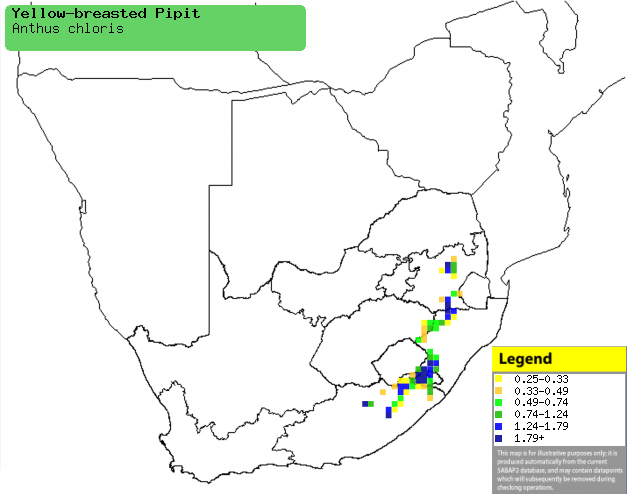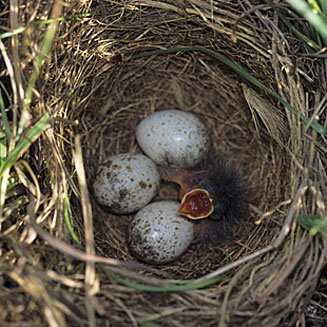|
Anthus chloris (Yellow-breasted
pipit)
[= Hemimacronyx chloris]
Geelborskoester [Afrikaans]; Iguru, Iguru-guru [Xhosa];
Geelborstpieper [Dutch]; Pipit à gorge jaune [French]; Gelbbrustpieper
[German]; Petinha-de-peito-amarelo [Portuguese]
Life
> Eukaryotes >
Opisthokonta
> Metazoa (animals) >
Bilateria >
Deuterostomia > Chordata >
Craniata > Vertebrata (vertebrates) > Gnathostomata (jawed
vertebrates) > Teleostomi (teleost fish) > Osteichthyes (bony fish) > Class:
Sarcopterygii (lobe-finned
fish) > Stegocephalia (terrestrial
vertebrates) > Tetrapoda
(four-legged vertebrates) > Reptiliomorpha > Amniota >
Reptilia (reptiles) >
Romeriida > Diapsida > Archosauromorpha > Archosauria >
Dinosauria
(dinosaurs) > Saurischia > Theropoda (bipedal predatory dinosaurs) >
Coelurosauria > Maniraptora > Aves
(birds) > Order: Passeriformes
> Family: Motacillidae > Genus: Anthus
Distribution and habitat
Endemic to South Africa, occurring from Mpumalanga through
western KwaZulu-Natal and marginally the Free State and Lesotho to the north east of the
Eastern Cape. It generally favours lush montane grassland with grass about 15-30
cm high on flat or gently sloping ground; unlike most other pipits it is not
attracted to recently burnt areas.
|
 |
|
Distribution of Yellow-breasted pipit in southern Africa,
based on statistical smoothing of the records from first SA Bird Atlas
Project (©
Animal Demography unit, University of
Cape Town; smoothing by Birgit Erni and Francesca Little). Colours range
from dark blue (most common) through to yellow (least common).
See here for the latest distribution
from the SABAP2. |
Movements and migrations
It is largely resident and sedentary, however
in the non-breeding season most descend to lower alititudes.
Food
It does most foraging on the ground feeding on insects,
such as grasshoppers (Orthoptera),
mantids and small beetles (Coleoptera).
Breeding
- It is usually monogamous, nesting solitary with the male defending his
territory by aerially displaying and calling; polygmy is rarely recorded.
- The nest (see image below) is built solely by the female, consisting of
an open cup of coarse grass stems and stalks, neatly lined with rootlets,
fine grass leaves and hair. It is typically built in a hollow in the ground
surrounded and concealed by grass tufts.
 |
|
|
Yellow-breasted pipit nest with chick and eggs,
Wakkerstroom, South Africa. [photo
Warwick Tarboton ©] |
|
- Egg-laying season is from October-March, peaking from November-February.
- It lays 1-4 eggs, which are incubated by both sexes for about 14 days.
- The chicks are fed by both parents, leaving the nest after approximately
14 days.
Threats
Globally Vulnerable due to the destruction of its
favoured habitat, montane grassland, from afforestation and overgrazing.
References
-
Hockey PAR, Dean WRJ and Ryan PG 2005. Roberts
- Birds of southern Africa, VIIth ed. The Trustees of the John Voelcker
Bird Book Fund, Cape Town.
|
